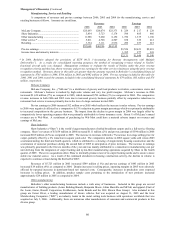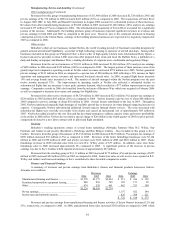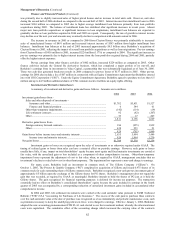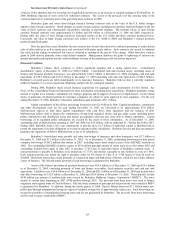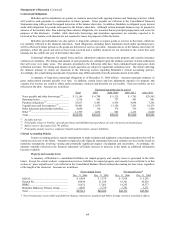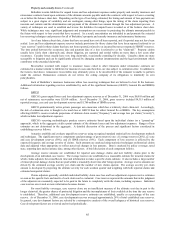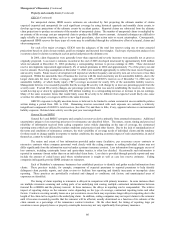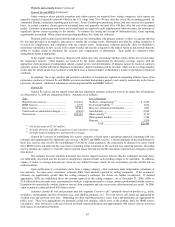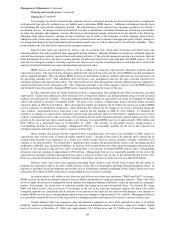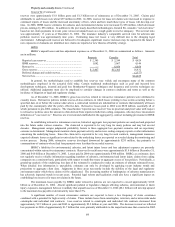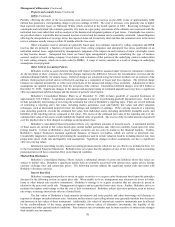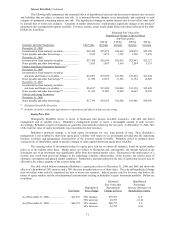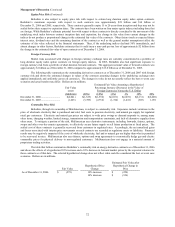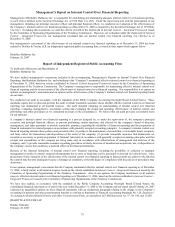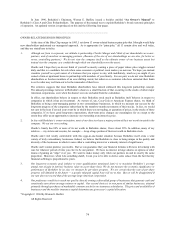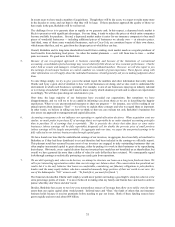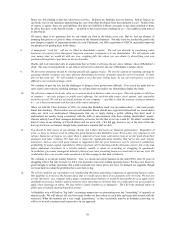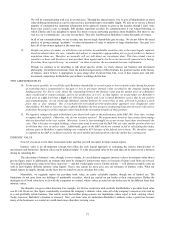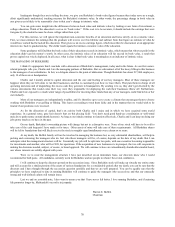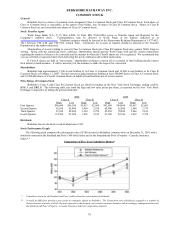Berkshire Hathaway 2006 Annual Report Download - page 70
Download and view the complete annual report
Please find page 70 of the 2006 Berkshire Hathaway annual report below. You can navigate through the pages in the report by either clicking on the pages listed below, or by using the keyword search tool below to find specific information within the annual report.
69
Property and casualty losses (Continued)
General Re (Continued)
reserves were approximately $1.8 billion gross and $1.3 billion net of reinsurance as of December 31, 2005. Claims paid
attributable to such losses were about $97 million in 2006. In 2006, reserves for mass tort claims were increased in response to
continued reports of losses and the increased uncertainty of how, when and how much these types of losses will develop over
time. In 2006, IBNR reserve estimates for asbestos and environmental claims were increased by $58 million, which decreased
pre-tax earnings by $58 million. In addition to the previously described methodologies, General Re considers “survival ratios”
based on net claim payments in recent years versus net unpaid losses as a rough guide to reserve adequacy. The survival ratio
was approximately 13 years as of December 31, 2006. The insurance industry’s comparable survival ratio for asbestos and
pollution reserves was approximately nine years. Estimating mass tort losses is very difficult due to the changing legal
environment. Although such reserves are believed to be adequate, significant reserve increases may be required in the future if
new exposures or claimants are identified, new claims are reported or new theories of liability emerge.
BHRG
BHRG’s unpaid losses and loss adjustment expenses as of December 31, 2006 are summarized as follows. Amounts
are in millions.
Property Casualty Total
Reported case reserves ...................................................... $ 2,385 $ 2,244 $ 4,629
IBNR reserves ................................................................... 1,082 3,067 4,149
Retroactive ........................................................................ — 8,054 8,054
Gross reserves ................................................................... $ 3,467 $13,365 16,832
Deferred charges and ceded reserves................................. (2,577)
Net reserves....................................................................... $14,255
In general, the methodologies used to establish loss reserves vary widely and encompass many of the common
methodologies employed in the actuarial field today. Certain traditional methodologies such as paid and incurred loss
development techniques, incurred and paid loss Bornhuetter-Ferguson techniques and frequency and severity techniques are
utilized. Additional judgments must also be employed to consider changes in contract conditions and terms as well as the
incidence of litigation or legal and regulatory change.
As of December 31, 2006, BHRG’s gross loss reserves related to retroactive reinsurance policies were attributed to
casualty losses. Retroactive policies include excess-of-loss contracts, in which losses (relating to loss events occurring before a
specified date on or before the contract date) above a contractual retention are indemnified or contracts that indemnify all losses
paid by the counterparty after the policy effective date. Retroactive losses paid in 2006 were $858 million, essentially all of
which pertained to pre-2006 contracts. The classification “reported case reserves” has no practical analytical value with respect
to retroactive policies since the amount is often derived from reports in bulk from ceding companies, who may have inconsistent
definitions of “case reserves.” Reserves are reviewed and established in the aggregate by contract including provisions for IBNR
reserves.
In establishing retroactive reinsurance reserves, historical aggregate loss payment patterns are analyzed and projected
into the future under various scenarios. The claim-tail is expected to be very long for many policies and may last several
decades. Management assigns judgmental probability factors to these aggregate loss payment scenarios and an expectancy
outcome is determined. Management monitors claim payment activity and reviews ceding company reports or other information
concerning the underlying losses. Since the claim-tail is expected to be very long for such contracts, management reassesses
expected ultimate losses as significant events related to the underlying losses are reported or revealed during the monitoring and
review process. During 2006, retroactive reserves developed downward by approximately $235 million, due primarily to
commutations of contracts where final loss payments were less than the recorded reserves.
BHRG’s liabilities for environmental, asbestos, and latent injury losses and loss adjustment expenses are presently
concentrated within retroactive reinsurance contracts. Reserves for such losses were approximately $3.8 billion at December 31,
2006 and $4.0 billion at December 31, 2005. Losses paid in 2006 were approximately $300 million. BHRG, as a reinsurer, does
not regularly receive reliable information regarding numbers of asbestos, environmental and latent injury claims from ceding
companies on a consistent basis, particularly with respect to multi-line treaty or aggregate excess of loss policies. Periodically, a
ground-up analysis of the underlying loss data of the reinsured is conducted to make an estimate of ultimate reinsured losses.
When detailed loss information is unavailable, estimates can only be developed by applying recent industry trends and
projections to aggregate client data. Judgments in these areas necessarily include the stability of the legal and regulatory
environment under which these claims will be adjudicated. The increasing number of bankruptcies of asbestos manufacturers
has adversely impacted trends in recent years. Potential legal reform and legislation could also have a significant impact on
establishing loss reserves for mass tort claims in the future.
The maximum losses payable by BHRG under retroactive policies are not expected to exceed approximately $10.8
billion as of December 31, 2006. Absent significant judicial or legislative changes affecting asbestos, environmental or latent
injury exposures, management believes it unlikely that unpaid losses as of December 31, 2006 ($8.1 billion) will develop upward
to the maximum loss payable or downward by more than 15%.
A significant number of recent reinsurance contracts are expected to have a low frequency of claim occurrence
combined with a potential for high severity of claims. These include losses from catastrophes, terrorism, and aviation risks under
catastrophe and individual risk contracts. Loss reserves related to catastrophe and individual risk contracts decreased from
approximately $3.5 billion at year end 2005 to approximately $2.2 billion at year end 2006. The decrease in reserves reflected
loss payments in 2006 of approximately $1.7 billion that were primarily attributable to the major hurricanes that occurred in 2005.



